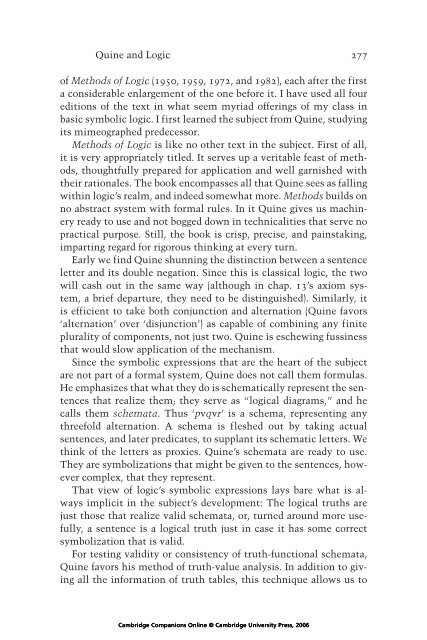Willard Van Orman Quine
Willard Van Orman Quine
Willard Van Orman Quine
Create successful ePaper yourself
Turn your PDF publications into a flip-book with our unique Google optimized e-Paper software.
<strong>Quine</strong> and Logic 277<br />
of Methods of Logic (1950, 1959, 1972, and 1982), each after the first<br />
a considerable enlargement of the one before it. I have used all four<br />
editions of the text in what seem myriad offerings of my class in<br />
basic symbolic logic. I first learned the subject from <strong>Quine</strong>, studying<br />
its mimeographed predecessor.<br />
Methods of Logic is like no other text in the subject. First of all,<br />
it is very appropriately titled. It serves up a veritable feast of methods,<br />
thoughtfully prepared for application and well garnished with<br />
their rationales. The book encompasses all that <strong>Quine</strong> sees as falling<br />
within logic’s realm, and indeed somewhat more. Methods builds on<br />
no abstract system with formal rules. In it <strong>Quine</strong> gives us machinery<br />
ready to use and not bogged down in technicalities that serve no<br />
practical purpose. Still, the book is crisp, precise, and painstaking,<br />
imparting regard for rigorous thinking at every turn.<br />
Early we find <strong>Quine</strong> shunning the distinction between a sentence<br />
letter and its double negation. Since this is classical logic, the two<br />
will cash out in the same way (although in chap. 13’s axiom system,<br />
a brief departure, they need to be distinguished). Similarly, it<br />
is efficient to take both conjunction and alternation (<strong>Quine</strong> favors<br />
‘alternation’ over ‘disjunction’) as capable of combining any finite<br />
plurality of components, not just two. <strong>Quine</strong> is eschewing fussiness<br />
that would slow application of the mechanism.<br />
Since the symbolic expressions that are the heart of the subject<br />
are not part of a formal system, <strong>Quine</strong> does not call them formulas.<br />
He emphasizes that what they do is schematically represent the sentences<br />
that realize them; they serve as “logical diagrams,” and he<br />
calls them schemata. Thus ‘pvqvr’ is a schema, representing any<br />
threefold alternation. A schema is fleshed out by taking actual<br />
sentences, and later predicates, to supplant its schematic letters. We<br />
think of the letters as proxies. <strong>Quine</strong>’s schemata are ready to use.<br />
They are symbolizations that might be given to the sentences, however<br />
complex, that they represent.<br />
That view of logic’s symbolic expressions lays bare what is always<br />
implicit in the subject’s development: The logical truths are<br />
just those that realize valid schemata, or, turned around more usefully,<br />
a sentence is a logical truth just in case it has some correct<br />
symbolization that is valid.<br />
For testing validity or consistency of truth-functional schemata,<br />
<strong>Quine</strong> favors his method of truth-value analysis. In addition to giving<br />
all the information of truth tables, this technique allows us to<br />
Cambridge Companions Online © Cambridge University Press, 2006
















